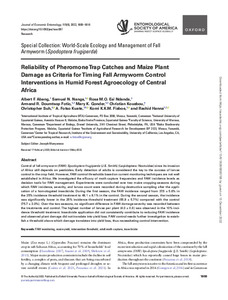| dc.contributor.author | Abang, A. |
| dc.contributor.author | Nanga, S.N. |
| dc.contributor.author | Ndanda, R.M.O. |
| dc.contributor.author | Doumtsop Fotio, A.R.P. |
| dc.contributor.author | Gonder, M.K. |
| dc.contributor.author | Kouebou, C. |
| dc.contributor.author | Suh, C. |
| dc.contributor.author | Fotso Kuate, A. |
| dc.contributor.author | Fiaboe, K. |
| dc.contributor.author | Hanna, R. |
| dc.date.accessioned | 2023-02-07T09:37:19Z |
| dc.date.available | 2023-02-07T09:37:19Z |
| dc.date.issued | 2022 |
| dc.identifier.citation | Abang, A.F., Nanga, S.N., Esi Ndanda, R.M., Doumtsop Fotio, A.R., Gonder, M.K., Kouebou, C., ... & Hanna, R. (2022). Reliability of pheromone trap catches and maize plant damage as criteria for timing fall armyworm control interventions in humid forest agroecology of central Africa. Journal of Economic Entomology, 115(6), 1806-1816. |
| dc.identifier.issn | 0022-0493 |
| dc.identifier.uri | https://hdl.handle.net/20.500.12478/8034 |
| dc.description.abstract | Control of fall armyworm (FAW) Spodoptera frugiperda (J.E. Smith) (Lepidoptera: Noctuidae) since its invasion of Africa still depends on pesticides. Early detection of adults is considered the key to the success of larvae control in the crop field. However, FAW control thresholds based on current monitoring techniques are not well established in Africa. We investigated the efficacy of moth capture frequencies and FAW incidence levels as decision tools for FAW management. Experiments were conducted over two maize cropping seasons during which FAW incidence, severity, and larvae count were recorded during destructive sampling after the application of a homologated insecticide. During the first season, the FAW incidence ranged from 37.5 ± 5.6% in the 25% incidence threshold treatment to 48.1 ± 8.1% in the control. During the second season, the incidence was significantly lower in the 25% incidence threshold treatment (55.8 ± 5.7%) compared with the control (75.7 ± 3.0%). Over the two seasons, no significant difference in FAW damage severity was recorded between the treatments and control. The highest number of larvae per plant (4.0 ± 0.6) was observed in the 10% incidence threshold treatment. Insecticide application did not consistently contribute to reducing FAW incidence and observed plant damage did not translate into yield loss. FAW control needs further investigation to establish a threshold above which damage translates into yield loss, thus necessitating control intervention. |
| dc.description.sponsorship | World Bank |
| dc.description.sponsorship | Cameroonian Government |
| dc.format.extent | 1806-1816 |
| dc.language.iso | en |
| dc.subject | Spodoptera Frugiperda |
| dc.subject | Maize |
| dc.subject | Yields |
| dc.subject | Pests of Plants |
| dc.subject | Insecticides |
| dc.title | Reliability of pheromone trap catches and maize plant damage as criteria for timing fall armyworm control interventions in humid forest agroecology of central Africa |
| dc.type | Journal Article |
| cg.contributor.crp | Roots, Tubers and Bananas |
| cg.contributor.affiliation | International Institute of Tropical Agriculture |
| cg.contributor.affiliation | National University of Equatorial Guinea |
| cg.contributor.affiliation | University of Maroua |
| cg.contributor.affiliation | Drexel University |
| cg.contributor.affiliation | Bioko Biodiversity Protection Program, Equatorial Guinea |
| cg.contributor.affiliation | Institute of Agricultural Research for Development, Cameroon |
| cg.contributor.affiliation | University of California |
| cg.coverage.region | Africa |
| cg.coverage.region | Central Africa |
| cg.coverage.country | Cameroon |
| cg.coverage.hub | Central Africa Hub |
| cg.researchtheme | Natural Resource Management |
| cg.researchtheme | Plant Production and Health |
| cg.identifier.bibtexciteid | ABANG:2022a |
| cg.isijournal | ISI Journal |
| cg.authorship.types | CGIAR and developing country institute |
| cg.iitasubject | Agronomy |
| cg.iitasubject | Food Security |
| cg.iitasubject | Maize |
| cg.iitasubject | Pests of Plants |
| cg.iitasubject | Plant Breeding |
| cg.iitasubject | Plant Health |
| cg.iitasubject | Plant Production |
| cg.journal | Journal of Economic Entomology |
| cg.notes | Open Access Article; Published online: 14 Dec 2022 |
| cg.accessibilitystatus | Open Access |
| cg.reviewstatus | Peer Review |
| cg.usagerightslicense | Creative Commons Attribution 4.0 (CC BY 0.0) |
| cg.targetaudience | Scientists |
| cg.identifier.doi | https://dx.doi.org/10.1093/jee/toac087 |
| cg.iitaauthor.identifier | Albert ABANG: 0000-0002-2791-9557 |
| cg.iitaauthor.identifier | Samuel Nanga Nanga: 0000-0003-4281-8284 |
| cg.iitaauthor.identifier | Armand Rodrigue Pascal Doumtsop Fotio: 0000-0001-7070-8440 |
| cg.iitaauthor.identifier | Fotso Kuate, A.: 0000-0002-5247-7519 |
| cg.iitaauthor.identifier | Komi Fiaboe: 0000-0001-5113-2159 |
| cg.iitaauthor.identifier | Rachid Hanna: 0000-0002-5715-0144 |
| cg.futureupdate.required | No |
| cg.identifier.issue | 6 |
| cg.identifier.volume | 115 |
| cg.contributor.acknowledgements | This work was supported by the Agricultural Investments and Market Development Project (PIDMA) funded by The World Bank and the Cameroonian Government. We also acknowledge the support from the maize CGIAR Research Program (CRP) through IITA and Drexel University’s Bioko Biodiversity Protection Program. |

